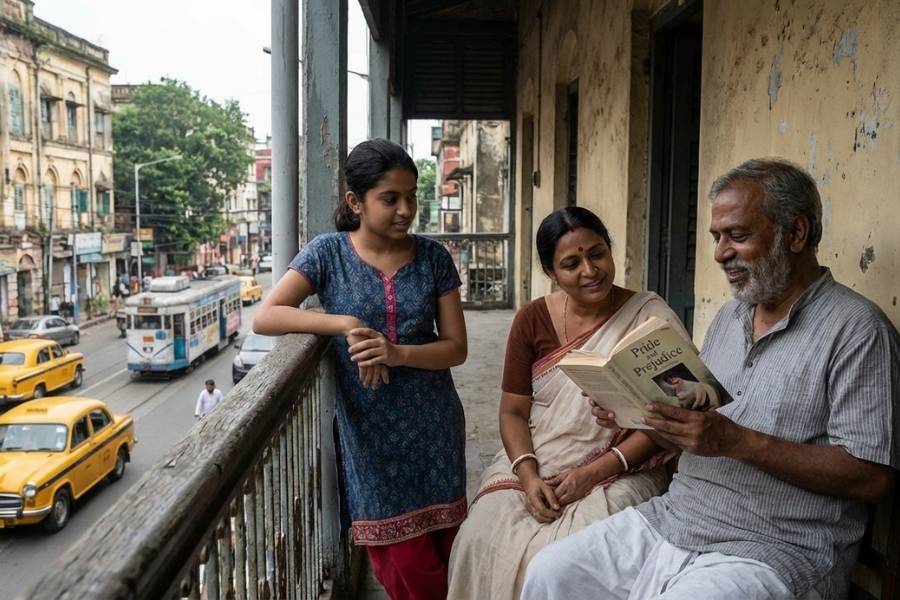 |
| The last sunset of 2008 on the Hooghly. Picture by Sudipto Chowdhury |
What is happening to Calcutta’s dress sense? At a Christmas Eve party at a well-known club, a middle-aged, pot-bellied, not-so-goodlooking man was spotted with a bevy of eight-to 10 beauties. The man, with his female companions, occupied a table closest to the dance floor, and was the first one to take the floor with one of the girls. The only count on which the man matched the women was in the flamboyance of attire. In black trousers and dinner jacket, and a gaudy yellow and black shirt with bold prints, and hair that was too obviously a wig, he was difficult to miss.
And now for the girls. His first dance partner was a lesson in bling. She was clad in a glittering orange and black sari that would make you want to run for shades. Hair that was dyed some strange shade of brown was pinned away from the face on one side with a jewelled clip, and a big, ornate, ring adorned her nose.
From here it got increasingly daring. One by one the girls peeled off jackets and shawls and added more body to the dance floor.
One girl wore a slinky short dress that — hold your breath — had slits in the front to offer a glimpse of her navel and stomach. She matched it with a red hat. A girl in an orange one-shouldered dress wore white knee-length boots with it. Another wore a skimpy white noodle-strapped top with pants of a very thin fabric that clung to her generous curves. Loud make-up completed the look for each girl.
The pallu was tossed asunder and the sari hem climbed up her legs and oblivious to it all, the orange lady danced. And boy, did they shake their booty? And as the man gyrated with his arms around one of the girls, she stretched out her hands and another pulled her away.
What is happening to Calcutta’s manners?
Price of coins
 |
While the city was busy ushering in the New Year, a festival was quietly pulling coin collectors to City Centre over three days. Mudra Utsav, organised by the Numismatic Society of Calcutta, was being held in conjunction with the 93rd conference of the Numismatic Society of India. Alongside, a coin exhibition introduced amateurs to Indian history. “Individual collectors have brought Indian coins from the fifth century onwards to the exhibition,” said S.K. Bose, the president of Numismatic Society of Calcutta (picture of East India Company-Bombay Presidency gold-gilt copper two pice above). The India Government Mint was also present, selling commemorative coins.
But the biggest draw was an auction on the second day conducted by the biggest coin auction house in the country — Todywalla Auctions. It brought down buyers from across the country.
The fiercest bidding took place over two items. One was a George VI Rs 2 coin of Burma that soared from its opening bid of Rs 4,000 to Rs 22,250. The other was a collection of 120 Mahatma Gandhi stamps of different countries, with an opening bid of Rs 2,000. It was picked up by an agent of a Mumbai-based collector for Rs 16,000. The highest price was fetched by an 1834 William IV silver pattern rupee, which was booked at Rs 1,80,000.
“Calcutta has the highest number of collectors,” said Malcolm F. Todywalla.
Cats on duty
 |
The cat is one up on the mouse. As hospitals and nursing homes in the city want the civic authorities to get rid of cats from their establishments, more and more market committees are approaching animal rights NGOs for more cats — to control rats in the markets.
Several committees from Sakher Bazar, Sarsuna market, Kharibari market, Diamond Harbour market and Gosaba market have adopted cats. They obtained the cats from an NGO in Behala.
“Cats are more effective in controlling rats than rat-killing poison. Placing poisoned baits in an open place like a market can be dangerous. A cat is more effective because rats don’t dare to come out when cats are ‘on duty’ in the market,” said Govinda Naskar at Sakher Bazar market in Behala.
Love-N-Care for Animals, a Behala-based NGO, rescues abandoned cats and kittens and keeps them on their own premises at Shibarampur. Following requests from hospital authorities they round up cats from the hospitals, which are cared for at the centre.
Now the cats are going places.
“We have a dog squad and two dog pounds at Dhapa and Entally but have no infrastructure to tackle the cat menace. Hence, we advise the hospital authorities to take the help of NGOs in controlling cats at the hospitals,” said municipal commissioner Alapan Bandyopadhyay.
The demand for cats keeps increasing. “We have so far handed over 80 cats to different market committees and some private individuals,” said Susmita Roy of Love-N-Care for Animals.
The NGO, said Roy, is now in possession of about 300 abandoned cats. It spends about Rs 1.3 lakh annually to feed them. “We are happy that the demand for adopting cats is on the rise. It is a relief for us, both mental and financial,” she added.
(Contributed by Poulomi Banerjee, Sudeshna Banerjee and Deepankar Ganguly)











